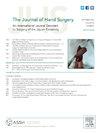Wide-Awake Local Anesthesia No Tourniquet Surgery for Zone VII Extensor Tendon Reconstruction: Stages in Active Range of Motion From Intraoperative to Final Recovery
IF 2.1
2区 医学
Q2 ORTHOPEDICS
引用次数: 0
Abstract
Purpose
We investigated chronological changes in active range of motion (ROM) of the metacarpophalangeal (MCP) joint after zone VII extensor tendon reconstruction with wide-awake local anesthesia no tourniquet (WALANT) surgery.
Methods
Reconstruction of the extensor tendons ruptured in zone VII of 82 fingers in 40 patients was performed using WALANT techniques. The mean patient age was 71.3 years. During surgery, we evaluated passive stretch distance and active contraction distance of the ruptured musculocutaneous unit. The sum of passive stretch distance and active contraction distance was defined as total excursion. In cases with total excursion ≥30 mm, we selected bridge tendon grafting for tendon reconstruction. In cases with total excursion <30 mm, end-to-side tendon transfer was performed. Active ROM of the MCP joint was measured before surgery; during surgery; 1, 3, and 5 months after surgery, and at the final follow-up.
Results
Extension lag of the MCP joint was 49.2° before surgery, improving to 2.9° during surgery, deteriorating to 18.7° at 1-month, and improving again to 15.6° at 3-months, 13.6° at 5-months, and 10.5° at the final follow-up. Meanwhile, the active flexion angle of the MCP was 87.9° before surgery, 87.3° during surgery, 67.6° at 1-month, 76.0° at 3-months, 79.7° at 5-months, and 81.0° at the final follow-up. Extension and flexion angles at each time point remained nearly constant regardless of whether tendon grafting or tendon transfer was used.
Conclusions
Extensor tendon reconstruction using WALANT surgery allowed intraoperative measurement of active ROM, confirming near-complete extension and flexion after reconstruction. The changes in ROM of the MCP joint during follow-up are an approximate indication of the progression of postoperative recovery.
Type of study/level of evidence
Therapeutic Ⅳ.
全清醒局麻无止血带手术用于第七区伸肌腱重建:从术中到最终恢复的活动范围阶段。
目的:研究全清醒局麻无止血带(WALANT)手术后第七区伸肌腱重建术后掌指关节活动活动度(ROM)的时间变化。方法:应用WALANT技术对40例82根手指VII区断裂的伸肌腱进行重建。患者平均年龄为71.3岁。在手术中,我们评估了破裂的肌皮单元的被动拉伸距离和主动收缩距离。被动拉伸距离和主动收缩距离之和定义为总偏移。对于总偏移≥30 mm的病例,我们选择桥式肌腱移植进行肌腱重建。结果:MCP关节伸展滞后术前为49.2°,术中改善至2.9°,1个月时恶化至18.7°,3个月时再次改善至15.6°,5个月时为13.6°,最后随访时为10.5°。同时,MCP的主动屈曲角术前为87.9°,术中为87.3°,1个月时为67.6°,3个月时为76.0°,5个月时为79.7°,最后随访时为81.0°。无论采用肌腱移植还是肌腱转移,每个时间点的伸屈角度几乎保持不变。结论:使用WALANT手术进行伸肌腱重建可以术中测量活动ROM,确认重建后接近完全的伸展和屈曲。随访期间MCP关节ROM的变化是术后恢复进展的一个近似指标。研究类型/证据水平:治疗性Ⅳ。
本文章由计算机程序翻译,如有差异,请以英文原文为准。
求助全文
约1分钟内获得全文
求助全文
来源期刊
CiteScore
3.20
自引率
10.50%
发文量
402
审稿时长
12 weeks
期刊介绍:
The Journal of Hand Surgery publishes original, peer-reviewed articles related to the pathophysiology, diagnosis, and treatment of diseases and conditions of the upper extremity; these include both clinical and basic science studies, along with case reports. Special features include Review Articles (including Current Concepts and The Hand Surgery Landscape), Reviews of Books and Media, and Letters to the Editor.

 求助内容:
求助内容: 应助结果提醒方式:
应助结果提醒方式:


